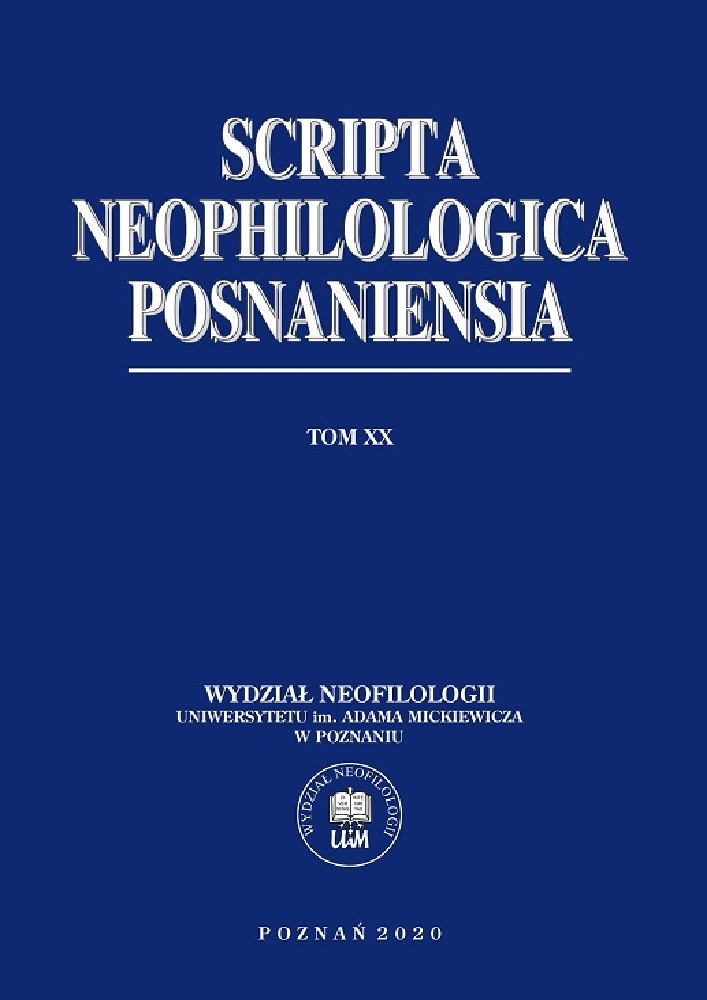Abstract
The advances in international and intercultural communication resulting in the multilingualism of native communicative communities and ultimately leading to the creation of the global communicative community, is well reflected in the lexical subsystem of many languages all around the world. This subsystem is continuously being enriched not only with numerous borrowings but also with the formations of hybrid type. As far as the Korean language is concerned, opening of the Korean borders to the world in 1876, also opened ‘the lexicon borders’ to the considerable number of Western loanwords, which, with time, started to be used in morpheme-based word-formation processes such as derivation and composition, as well as in new word-formation processes – among them blending and reanalysis. Despite the fact that there are two types of hybrid derivatives distinguished according to the origin of their counterparts (roots and affixes), which are coined and used in contemporary Korean, this article, given its scope, focuses only on the derivatives having the Koreanized bases of European provenance.
References
Bańczerowski, J. 2001. “The linguistic legacy of Ludwik Zabrocki”. In: Puppel, S. (ed.). The Ludwik Zabrocki Memorial Lecture. Poznań: Wydział Neofilologii UAM. 8–49.
Bauer, L. 1983. English word-formation. Cambridge Textbooks in Linguistics. Cambridge: Cambridge University Press.
Bernard, R. 2004. “Inflexion and derivation”. In: Strazny, P. (ed.). Encyclopedia of Linguistics. London/New York: Routledge. 529–530.
Bird Bishop, E. 1897. Korea and her neighbors. Seoul: Yonsei University Press.
Bloomfield, L. 1933. Language. London: Ruskin House, George Allen and Unwin, Ltd.
Borowiak, A. 2015. “On some selected problems of Korean abbreviology”. International Korean Journal of Humanities and Social Sciences 1. 137–164.
Borowiak, A. 2016. “On some properties of acronyms used in Korean”. International Korean Journal of Humanities and Social Sciences 2. 123–155.
Borowiak, A. 2019. “Growing influence of hybridization on neologisms in the contemporary Korean”.
The 8th International Conference of Oriental Studies – Challenges of Interdisciplinary and Multidisciplinary Approach, PAN-UW, Warsaw, 25–26 Nov. 2019.
Choe, Sang Jin (최상진). 1993. 연쇄 합성어의 어휘 형성에 대하여, [in:] 어문논 총, 제8집, 경희대학교 국어국문학과. 47–63.
Choo, Miho and Kwak, Hye-young. 2008. Using Korean – A guide to contemporary usage. Cambridge: Cambridge University Press.
Choo, Miho and w. O’Grady. 1996. Handbook of Korean vocabulary – A resource for word recognition and comprehension. Seoul: 한국문화사.
Connor, M. 2009. Asia in focus – The Koreas. Santa Barbara, CA: ABC-CLIO, LLC.
Dressler, W.U. and M. Kilani-Schoch. 2016. “Natural morphology”. In: Hippisley A. and G. Stump (eds.). The Cambridge Handbook of Morphology. Cambridge Textbooks in Language and Linguistics. Cambridge: Cambridge University Press. 356–389.
Dressler, W.U. 2005. “Towards a natural morphology of compounding”. Linguistica 45.2. 29–40.
Elliot Griffis, W. 1894. Corea: The Hermit nation. New York: Charles Scribner’s Sons.
Hamans, C. 2015. “Global language contact”. In: P. Chruszczewski. (ed.). Languages in contact 2014.
Wrocław–Washington D.C.: Wydawnictwo Wyższej Szkoły Filologicznej we Wrocławiu. 159–181.
Hamans, C., Fisiak, J. and E.H. Jahr. 2009. “Degrammaticalization and reanalysis”. European Parliament, Brussels/ Strasbourg, Adam Mickiewicz University in Poznań. Kristiansand: Uniersity of Adger. 145–167.
Haspelmath, M. 1995. “The growth of affixes in morphological reanalysis”. In: Booij, G. and J. Marle. (eds.). Yearbook of morphology 1994. Dordrecht: Kluwer Academic Papers. 1–29.
Huszcza, R. 2011. “Wschodnioazjatycki krąg cywilizacji pisma – lingwistyczna analiza pojęcia”. In: L. Sudyka (ed.). Orientalia Commemorativa. Kraków: Wydawnictwo Uniwersytetu Jagielońskiego. 115–132.
Jeon, Myeong-mi (전명미), Choi Dong Ju (최동주). 2007. 신어의 단어 형성법 연구 –2002·2003·2004 신어를 대상으로-, [in:] 한민족어문 학, 제50집, 한민족어문학회, pp. 37–70.
Kang, Hee-suk (강희숙). 2016. 한국어 어문 규정의 이 해, 서울: 연락.
Kastovsky, D. 1977. “Word-formation, or: at the crossroads of morphology, syntax, semantics and the lexicon”. Folia Linguistica 10.1–2. 1–33.
Kastovsky, D. 1982. “Word-formation: a functional view”. Folia Linguistica 16.1–4. 181–198.
Kim, Chang-sop (김창섭). 1996. 국어의 단어 형성과 단어 구조 연 구, 국어학 총서 21, 서울: 태학사.
Kim, Chang-sop (김창섭). 2008. 한국어 형태론 연 구, 서울: 태학사.
Kim, Jung-nam (김정남). 2005. 국어 형용사의 연 구, 서울: 도서출판 연락.
Kim, Kwang Hae (김광해), Kwon Jae-il (권재일), Lim Ji-ryong (임지룡), et al. 1999. 국어 지식 탐 구, 서울: 도서출판 박이정.
Kim, Seung Gon (김승곤). 2009. 21세기 우리말본 연 구, 국어학총서 · 문법론, 서울: 도서출판 경진문화.
Ko, Jong-suk (고종석). 2014. 감연된 언어 -국어의 변두리를 담은 몇 개의 풍경 화, 고양시: 개마고원.
Koh, Jae Sol (고재설). 1999. 동사 ‘-하’와 형용사 ‘-하’, [in:] 언어학 , 제4권, 대한언어학회. 25–45.
Lee, Hyeon Gyu (이현규). 1983. 국어형태구조의 사적 연구-접미사「-하다」,「-답다」를 중심으로-, [in:] 언어 학, 제43호, 한국어문학회. 155–188.
Lee, Kwang-ho (이광호). 2009. 국어 파생 접사의 생산성 저지에 대한 계량적 연 구, 국어학 총서 65, 서울: 태학사.
Lee, Nam-suk (이남숙). 2000. 국어 연쇄 합성어 어휘 형성에 관한 연 구, 慶熙大學校 大學院: 國語 國文學科, 석사학위논문.
Lim Ji-ryong (임지룡), Lee Eun-kyu (이은규), Kim Jong-rok (김종록) et al. 2005. 학교문법과 문법교 육, 서울: 도서출판 박이정.
Lim, Hong-bin (임홍빈). 1996. 외래어 표기의 역사, [in:] 새국어생 활, 제6권, 4호. 3–40.
Mattiello, E. 2013. Extra-grammatical morphology in English – abbreviations, blends, reduplicatives and related phenomena. Topics in English Linguistics 82, Berlin/Boston: De Gruyter Mouton. National Institute of Korean Language, Dictionary of Standard Korean https://opendict.korean.go.kr
/main (accessed 2019-03-21). Plag, I. 2003. English word-formation. Cambridge Textbooks in Linguistics. Cambridge: Cambridge University Press.
Puppel, S. 2017. ECOLI[S]2. Essays and notes on ecolinguistic synergy and synthesis. Scripta de Communicatione Posnaniensi, Prace Naukowe Katedry Ekokomunikacji UAM, Vol. 8, Poznań: Wyd. UAM.
Shim, Jae-kee (심재기). 1982. 국어 어휘 론, 서울: 집문당.
Sohn, Ho-Min. 2001. The Korean language. Cambridge: Cambridge University Press.
Song, Jae Jung. 2005. The Korean language: structure, use and context. London/New York: Routledge.
Szymanek, B. 2012. Introduction to morphological analysis. Warszawa: Wydawnictwo Naukowe PWN.
Weinreich, U. 1953. Languages in contact, findings and problems. New York: Publications of the Linguistic Circle of New York.
Zabrocki, L. 1963. Wspólnoty komunikatywne w genezie i rozwoju języka niemieckiego. Część I – Prehistoria języka niemieckiego. Wrocław–Warszawa–Kraków: Zakład Narodowy im. Ossolińskich.
Zabrocki, L. 1980. „Phonologie und distinktive Morphologie”. In: Bańczerowski, J. (ed.). U podstaw struktury i rozwoju języka/ At the foundation of language structure and development. Warszawa– Poznań: PWN. 105–112.
